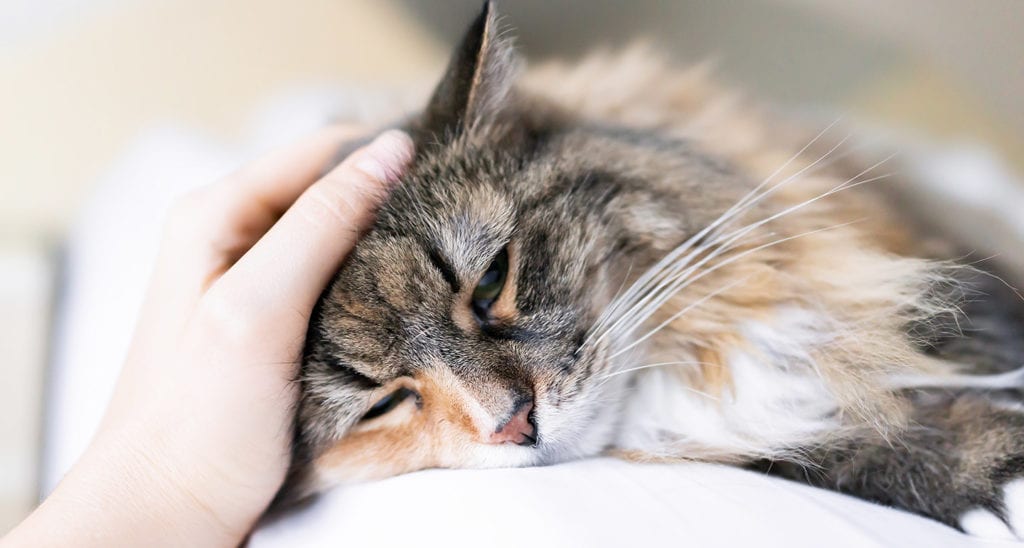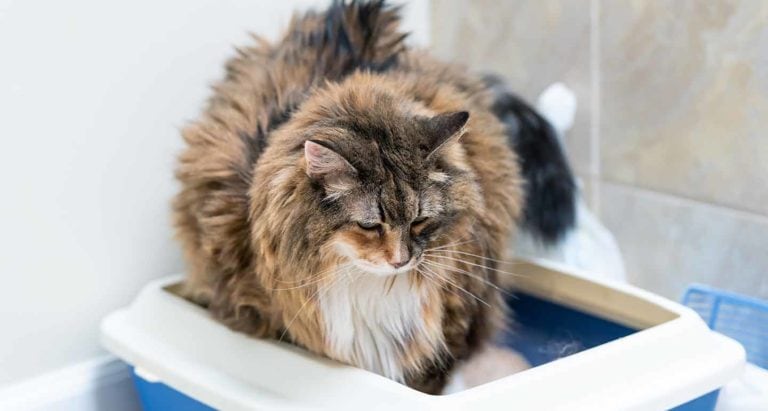As a veterinarian, I believe some of the most difficult times we face are to give pet parents bad news, and cancer in older cats and dogs is often seen as some of the worst. Telling a client that their cat has cancer, and explaining cat cancer symptoms and treatments, are among the hardest things I have to do. There are some cases that one never forgets; one of mine was a cat named “Jinx.”
I was a brand-new graduate and saw Jinx during one of my first weeks of internship. Jinx came in for a cough, and I thought to myself that it would be an easy diagnosis of either asthma or hairballs. To my surprise, his chest X-ray showed multiple growths throughout the lungs. Jinx, unfortunately, had metastatic cancer.
When it comes to cancer in cats—and especially cancer in older cats—there is a lot to understand. From diagnosis to cat cancer symptoms and treatments, here’s what concerned pet parents need to know.
Cancer in Cats Defined
Cancer is also called “neoplasia” or “new growth.” All of the cells that comprise the body are controlled by genes that tell those cells things like what proteins to make, how quickly to grow and when to die. Cancer cells have lost some of this control, specifically when to stop dividing and when to die. Cells that have become cancerous, or “malignant,” grow and divide uncontrollably, causing organs to lose function and spreading to different organs, causing them to also lose normal function.
Causes of Cancer in Cats
The next and most obvious question is, “What causes cancer?” Depending on the type of cancer, this is known or postulated. For example, mammary gland cancer (breast cancer) is directly related to reproductive hormone levels (estrogen and progesterone). Environmental factors, such as secondhand smoke, increase the likelihood of lymphoma in cats. Vaccine adjuvants (compounds added to vaccines that sometimes have the side effect of stimulating the immune system) have been linked with the development of fibrosarcoma. Even viruses, such as feline leukemia virus (FeLV), can cause cancer genes, called oncogenes, to be turned on. For the most part, we don’t know why cancer develops in pets—or in people for that matter. It’s likely a combination of genetic and environmental factors.
Senior cats, those in their final life stage (aged 10 years or older), are more likely to develop cancer. Although there are many types of cancer that affect every organ in the body, below I will focus on three of the more common types of cancer in older cats.
3 Most Common Types of Cancer in Older Cats
Lymphoma
As I mentioned, the virus FeLV can cause cancer in cats. About 20 to 30 years ago, this virus led to cancer development in young cats (2 to 5 years old). With the advent of virus testing, vaccination against FeLV and selective breeding, the cancer caused by this virus has diminished greatly. However, lymphoma (not associated with FeLV) is still the most common cancer in older cats, affecting felines aged 8 to 12 years.
Lymphoma, or lymphosarcoma, is the cancer of white blood cells called the lymphocytes. Lymphocytes are a very important defensive cell line. They are responsible for directing the immune system, creating antibodies and destroying invaders like bacteria and viruses. Lymphocytes are found throughout the body because they travel in both the blood and the lymphatic system. Many of these cells are housed in the spleen, liver and lymph nodes.
Unlike dogs and humans, lymphoma in cats primarily affects the gastrointestinal tract. Rarely will cats have enlarged peripheral lymph nodes (those in the armpit, inner thigh and under the jaw). Certain breeds, such as Siamese cats, have a higher incidence of developing lymphoma than others.
Lymphoma Cat Cancer Symptoms
Unfortunately, there are no specific signs of cancer in cats that will give a diagnosis of lymphoma. But most cats will display one or more of the following:
- Lack of appetite
- Lethargy
- Weight loss
- Hiding
- Vomiting
- Diarrhea
- Weakness
- Difficulty breathing
- Excessive thirst and urination
- Pale gums
It’s important to note that many problems and diseases will cause these same symptoms and they are not specific to cancer. In fact, the top three signs—decreased appetite, lethargy and weight loss—occur in cats who have almost any illness.
Lymphoma Cat Cancer Diagnosis
The most important aspects of getting a correct diagnosis of lymphoma are the physical exam, blood tests and imaging.
Imaging entails getting radiographs (X-rays) and ultrasound studies of the chest and abdomen. Enlarged lymph nodes, fluid and enlarged organs can be seen with ultrasound.
While lab tests and ultrasound can provide evidence that the cause of a particular cat’s problem is likely lymphoma, the only way to get a definitive diagnosis is to sample affected organs using aspiration or biopsy to find cancer cells. Newer tests such as flow cytometry and PARR (polymerase chain reaction for antigen receptor rearrangement) can help identify cancer cells in blood and from tissue, but cannot replace an expert’s eyes. Samples obtained from enlarged lymph nodes or an abnormal organ (like a thickened intestinal wall or enlarged kidney) will be examined microscopically to see if there are abnormal lymphocytes, providing a diagnosis of lymphoma.
Once lymphoma has been confirmed, the cell line affected (B cells or T cells) is usually determined. B-cell lymphoma tends to be the one affecting the GI tract and is less aggressive than T-cell lymphoma. Sometimes a sample of the bone marrow is taken to see if lymphoma is present there, too. Determination of the cell type, if the bone marrow is affected and if other organs besides the GI tract are affected, is called “staging.” Staging is key to treatment and outcome. The aggressiveness of the cancer, its location and its cell line are used to devise the chemotherapy protocols and give an idea of survival times.
Lymphoma Cat Cancer Treatment
Lymphoma is not a type of cancer that is amenable to surgery. This is because once it is found, the assumption is that tumor cells are everywhere. Remember, lymphoma affects the immune system, so anywhere the immune system is (which is everywhere!) cancerous lymphoma cells may live. Sometimes, in cases where the lymphoma is causing a crisis like obstructing the flow of food into the GI tract or blocking the windpipe, surgery may be performed.
The mainstay of lymphoma treatment is chemotherapy. Many protocols involving different drug combinations are being used and studied for it. The most recent involves using four drugs over 19 weeks. Approximately 65 percent of cats will go into remission using this protocol. Unlike people, pets rarely lose their hair during chemotherapy. Other complications, such as vomiting and nausea, are uncommon and affect about 15 percent of cats receiving lymphoma chemotherapy.
Other treatments include diet modification to include a high percentage of omega-3 fatty acids, supplements and nutraceuticals. Supplements added to the diet like antioxidants and B-glucans (immuno-modulators that basically change how the immune system functions) show some promise, but their routine use is controversial. Some research has noted decreased effectiveness of chemotherapy drugs when antioxidants are used. The latest treatment research for cancer in cats focuses on gene therapy and gene modification.
Lymphoma Cat Cancer Prognosis
The outcome for a cat with lymphoma is dependent on staging. In general, T-cell lymphoma of the chest carries a worse outcome than B-cell lymphoma of the GI tract. Cats with feline leukemia virus also have shorter remission and survival times. The average survival time for cats with gastrointestinal lymphoma is seven to nine months.
Squamous Cell Carcinoma
Squamous cell carcinoma (SCC) is commonly termed “skin cancer.” It is the second most common cause of cancer in cats. Two major forms of squamous cell carcinoma exist: The first being cutaneous or skin cancer, which affects the skin, primarily on the face; and the second being oral squamous cell carcinoma, which affects the inside of the mouth, commonly on the back of tongue and tonsils. Oral SCC is the most common form of cat mouth cancer, causing 70 to 80 percent of oral cancerous tumors.
A couple of studies noted that cats exposed to tobacco smoke double their chances of developing oral SCC. Other studies found evidence of papilloma virus in the tumor cells.
For non-oral, “true” skin cancer, exposure to ultraviolet light or sunbathing is the biggest risk factor. Cats with white fur are at greater risk than darker-coated cats. Ultraviolet radiation leads to the formation of inflammatory proteins called cytokines and oxidative compounds called free radicals. Both cause DNA mutations in skin cells, leading to cancer.
Squamous Cell Carcinoma Cat Cancer Symptoms
Oral squamous cell carcinoma is an aggressive cancer. It invades deeper tissues (even bone) and can involve the lymph nodes in the area. With oral SCC, typical signs of cancer in cats are:
- Drooling
- Blood-tinged saliva
- Difficulty chewing and swallowing
- Malodorous breath
- Nose bleeds
- Loose teeth
- Lack of appetite
- Weight loss
Meanwhile, cat skin cancer (cutaneous squamous cell carcinoma) affects mainly the head, ears, eyelids and nose. These tumors are firm plaques that can be ulcerated, bleed and scab over. They may also present as non-haired lumps or bumps. Cat skin cancer rarely spreads to other organs, but it can recur in the same area after initial removal.
Squamous Cell Carcinoma Cat Cancer Diagnosis
A lump or bump found on the skin should be described and measured by your veterinarian. Unfortunately, just the appearance, color and size of a lump will not allow us to determine if the growth is malignant (cancerous) or benign (noncancerous). If the lesion is on the face and if it’s ulcerated, it’s likely malignant.
Performing a biopsy is the most accurate and best way to get a definitive diagnosis for cat skin cancer. The same goes for lesions inside the mouth and cat mouth cancer.
Additionally, for oral lesions, X-rays of the skull and jaw or a CT scan provide information of the growth’s location, if the growth is affecting deeper tissues and if the tumor invaded bones. Similar to staging for lymphoma, blood tests, X-rays of the chest and genetic analysis of the tumor may be recommended.
Squamous Cell Carcinoma Cat Cancer Treatment
For skin lesions, surgery to remove the entire growth and some of the normal surrounding tissue provides the best outcome. The surgery may be a traditional excision, or your veterinarian may perform cryosurgery or even laser surgery. Local radiation therapy, termed brachytherapy, using strontium can also be used in areas where surgery would cause other problems—for example, if an entire eyelid was affected. Newer treatments include photodynamic therapy, which uses a combination of a drug that sensitizes skin cells to light and a specific light-frequency laser to target cancer cells.
The more aggressive, oral squamous cell carcinomas are best treated with surgery as soon as they are found. The problem is that by the time a cat has difficulty swallowing or has bloody saliva, the tumor is large and cannot be removed entirely. In those cases, a combination of surgery to remove what can be removed, followed by radiation therapy, may be recommended. Unfortunately, oral SCC does not respond well to chemotherapy and has a mediocre response to radiation therapy. Large, invasive tumors affecting the back of the tongue, tonsil and throat cause a poor quality of life and euthanasia should be considered.
Squamous Cell Carcinoma Cat Cancer Prognosis
Cutaneous SCC carries a good prognosis after complete removal, as long as tumor cells are not left in the area. Oral SCC carries a much worse prognosis. Only 10 percent of affected cats live one year after diagnosis and treatment.
Mammary Gland (Breast) Cancer
Mammary gland carcinoma, or breast cancer, affects 17 percent of female cats and is the third most common type of cancer in cats. Very few mammary gland growths in cats are benign—85 to 90 percent are malignant and spread to lymph nodes, lungs and the chest cavity.
There is a definite link between sex hormones and the development of mammary gland carcinoma in cats. This has been studied extensively to the point that we know if a cat is spayed (ovaries and uterus removal) prior to 6 months of age, the risk of getting this cancer drops by 91 percent compared to unspayed cats. If a cat isn’t spayed until 1 year of age, the risk still reduces by 86 percent compared to cats who are not spayed.
In addition to estrogen, obese cats and those genetically predisposed to obesity have a higher risk of this cancer. Oncogenes (DNA coding for altered cell growth and cloning) are regulated by estrogen levels: Too much and too long of exposure results in mammary cells becoming cancerous.
The bottom line is: Spay your kitten before they turn 6 months old!
Mammary Gland Cat Cancer Symptoms
Cats have 10 mammary glands, five on either side of the abdomen. For the most part, mammary gland carcinoma is an incidental finding, meaning that during a veterinary checkup, lumps inside breast tissue are found. Pet parents may find these lumps, too. Sometimes, these tumors secrete hormones, similar to insulin, which cause low blood sugar. When it comes to the mammary glands, signs of cancer in cats are non-specific but may include:
- Weight loss
- Lethargy
- Excessive grooming of the abdomen
- Redness, bleeding and sores associated with the nipples
- Weakness, tremors or drooling due to low blood sugar
- Lack of appetite
- Difficulty breathing, if it has spread to the lungs
Mammary Gland Cat Cancer Diagnosis
I teach my students that if a dog or cat has a lump or bump, aspirate it! This means the vet uses a needle and syringe to suction some cells out of the lump to determine what is causing it. Unfortunately, aspiration of mammary glands doesn’t provide an accurate diagnosis. Any lump or bump associated with a cat’s mammary gland should be biopsied to get a true diagnosis.
Additionally, staging of the cancer should be performed. This includes blood tests to check organ function, blood cell counts, protein levels and calcium levels. The lymph nodes associated with the mammary glands should be sampled, too, to see if the cancer spread to them. X-rays of the lungs are done to check for metastasis and, in some situations, ultrasound of the chest and abdomen is recommended.
Mammary Gland Cat Cancer Treatment
The mainstay of mammary gland carcinoma treatment is surgery. The extent of surgery (single mastectomy versus radical mastectomy) depends on how many mammary glands are affected and if there is lymph node enlargement. Affected lymph nodes are removed with the cancerous mammary tissue.
Because this cancer type is locally aggressive and will spread to other mammary glands readily, chemotherapy will be recommended after surgery. Radiation therapy and chemotherapy (without surgery) have not been found to be that helpful. Hormone blockers like Tamoxifen, used in women diagnosed with breast cancer, don’t help either.
Mammary Gland Cat Cancer Prognosis
Cats undergoing more aggressive surgery have longer survival times. With surgery alone, the median survival time is 10 to 12 months. Surgery and chemotherapy nearly triple the survival time to more than 900 days.
Share:









